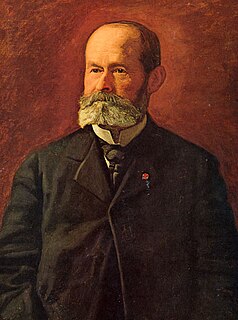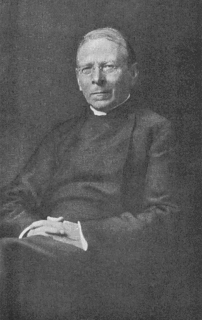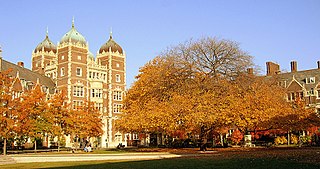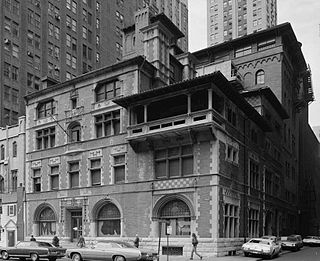
Benjamin Smith Barton was an American botanist, naturalist, and physician.

Karl Theodore Francis Bitter was an Austrian-born American sculptor best known for his architectural sculpture, memorials and residential work.

Daniel Garrison Brinton was an American archaeologist and ethnologist.

Thomas Alexander Scott was an American businessman, railroad executive, and industrialist. President Abraham Lincoln in 1861 appointed him the U.S. Assistant Secretary of War, and during the American Civil War railroads under his leadership played a major role in the war effort. He became the fourth president of the Pennsylvania Railroad (1874-1880), which became the largest publicly traded corporation in the world and received much criticism for his conduct in the Great Railway Strike of 1877 and as a "robber baron." Scott helped negotiate the Republican Party's Compromise of 1877 with the Democratic Party; it settled the disputed presidential election of 1876 in favor of Rutherford B. Hayes in exchange for the federal government pulling out its military forces from the South and ending the Reconstruction era. In his final years, Scott made large donations to the University of Pennsylvania.

George Hodges (1856–1919) was an American Episcopal theologian, born at Rome, New York, and educated at Hamilton College. He served at Calvary Church, Pittsburgh, Pennsylvania, from 1881 to 1894. In 1893 he helped establish the Kingsley Association in Pittsburgh, an organization dedicated to helping immigrant workers. Afterward, he became the dean of the Episcopal Theological School at Cambridge, Massachusetts. "The high esteem in which his religious messages are held by the reading public" resulted in a number his books being reissued as a second edition in 1914.

Cope and Stewardson (1885–1912) was a Philadelphia architecture firm founded by Walter Cope and John Stewardson, and best known for its Collegiate Gothic building and campus designs. Cope and Stewardson established the firm in 1885, and were joined by John's brother Emlyn in 1887. It went on to become one of the most influential and prolific firms of the late-nineteenth and early-twentieth centuries. They made formative additions to the campuses of Bryn Mawr College, Princeton University, the University of Pennsylvania, and Washington University in St. Louis. They also designed nine cottages and an administrative building at the Sleighton School, which showed their adaptability to other styles, because their buildings here were Colonial Revival with Federal influences. In 1912, the firm was succeeded by Stewardson and Page formed by Emlyn Stewardson and George Bispham Page.
John Roger Kirkpatrick Scott was a Republican member of the U.S. House of Representatives from Pennsylvania.

Henry Augustus Pilsbry was an American biologist, malacologist and carcinologist, among other areas of study. He was a dominant presence in many fields of invertebrate taxonomy for the better part of a century. For much of his career, his authority with respect to the classification of certain substantial groups of organisms was unchallenged: barnacles, chitons, North American terrestrial mollusks, and others.
The Thomas A. Scott Professorship of Mathematics is an academic grant made to the University of Pennsylvania. It was established in 1881 by the railroad executive and financier: Thomas Alexander Scott.

Wilson Brothers & Company was a prominent Victorian-era architecture and engineering firm established in Philadelphia, Pennsylvania, that was especially noted for its structural expertise. The brothers designed or contributed engineering work to hundreds of bridges, railroad stations and industrial buildings, including the principal buildings at the 1876 Centennial Exposition. They also designed churches, hospitals, schools, hotels and private residences. Among their surviving major works are the Pennsylvania Railroad, Connecting Railway Bridge over the Schuylkill River (1866–67), the main building of Drexel University (1888–91), and the train shed of Reading Terminal (1891–93), all in Philadelphia.

Frank Miles Day was a Philadelphia-based architect who specialized in residences and academic buildings.

James Patterson Sterrett was a Pennsylvania jurist.

Rev. Benaiah Longley Whitman was the 11th president of Colby College, and later Columbian College.
Ida Augusta Keller was an American plant physiologist and teacher in Philadelphia.
Emily Ray Gregory was an American zoologist who is best known as holding the American Women's Table at the Naples Zoological Station and her work with the United States War Trade Board and the United States Treasury Department.
The Hayden Memorial Geological Award is presented by the Academy of Natural Sciences of Drexel University, Philadelphia, Pennsylvania, USA. It was named after US geologist Ferdinand Vandeveer Hayden. The award was established in 1888 and first awarded in 1890.
The following is a list of works about Philadelphia, Pennsylvania, USA.
Roland Post Falkner was a United States economist and statistician.
The Agnes Hoppin Memorial Fellowship was an academic fellowship intended to “lift the restrictions on women in the study of archaeology”. It was established at the American School of Classical Studies in Athens in 1898 by the Hoppin family.
Phoebe Davis Natt (1847–1899) was an American painter.













